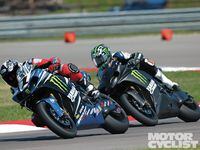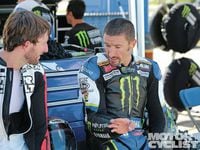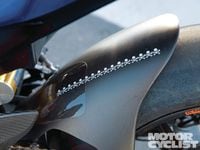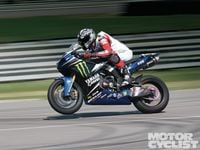This is going to be fun. A fresh set of slicks, a beautiful racetrack, and a bright sunny day to sample the most capable superbike on the Continent. That's what I kept telling myself, anyway, because riding motorcycles is supposed to be fun. It's about feeling the wind flow past you, carving through corners, and experiencing the hum of the engine. We've all enjoyed those days on a motorcycle. It's what keeps us coming back. Then why did everyone I tell about my opportunity to ride Josh Hayes ' championship-winning Yamaha YZF-R1 chuckle and raise an eyebrow? I told myself they were crazy, and tried not to remind myself how nervous I should be to ride a bike with such an impressive racing pedigree.
At first sight, the R1 was not terribly inviting. It sat stoically in the Graves pit on a workbench, facing away from me, with tire warmers on. One mechanic buttoned on the bellypan while another warmed the engine up with quick revs. The sound is extremely menacing, each blip of the throttle ending with a flurry of cracks and pops as though the unburned gas is backfiring from fear alone. Picture Hannibal Lector clearing his throat as someone unbuckles his straightjacket.
Shod with fresh Dunlop slicks hot from the warmers and still barking its crossplane threats, the bike taunted me. I swung my 6-foot-2 frame over the grumbling monster and was met with my first surprise: I could barely get both feet flat on the ground. The seat is narrow but incredibly tall, the combined result of a stiff shock and a lot of ride height. Last time I was on a bike this tall it had knobbies and a kick-starter.
Fortunately, I didn’t have much time to think about the Yamaha’s pedigree or worry about crashing an undoubtedly six-figure motorcycle. My initial impressions blurred into a few laps of euphoria and panic. The bike rocketed out of every corner while the chassis and brakes jointly laughed at my attempts to use them. Every time I touched the brake lever it seemed like I was instantly going too slow and had to accelerate to get to the apex, and when I thought I was slicing swiftly through a corner my knee was still inches from the ground.
In my first session I wheelied accidentally countless times while only opening the throttle fully on the front straightaway and briefly in the back of the circuit in fourth gear. Hayes, on the other hand, was wide open 10 times a lap according to the bike’s data logging system. I had serious work to do. Amid the roller-coaster of emotions—joy and terror careening back and forth—I began forming some questions in the hopes of wrapping my head around this overwhelming machine.
For one thing, why is there such tremendous grip from the rear tire? A stock literbike, even with race rubber, squats noticeably before digging in and eventually spinning the rear tire under power. The Graves R1 planted itself mid-corner and, no matter how much power I fed through the rear contact patch, stayed pitched forward, ready to attack. When it felt like the rear contact patch should break loose under power the bike simply dug in harder and fired toward the next corner. No drama, no pumping up and down from the shock, just pure acceleration. Sure, some credit goes to the huge 195/65-17 Dunlop slick mounted astern, but there’s more.
Rick Hobbs, Hayes’ crew chief, explained to me later, “This bike has quite a bit of swingarm angle, with the pivot pointed down to the axle, so we end up with a lot of mechanical grip.” In other words, when power is applied and the rear suspension squats (albeit minimally), the swingarm pushes the wheel back as it pivots and helps the tire dig into the pavement. With the relatively stiff shock and high ride height, the bike feels too rigid to work properly. But, let me tell you, work properly it does.
Another question: Why is the fork so stiff? Josh Hayes’ preference, it turns out, and he knows a thing or two about setting up a bike. It’s hard to get used to, but as unyielding as the front suspension feels it is amazingly obedient, especially considering the seat is so high. Turn-in is crisp and light as you would expect, and the Graves R1 doesn’t show it’s 370-plus pounds even transitioning from side to side in fast sets of corners.
Question number three: What planet are these brakes from and do they have a website? Initial bite from the sintered pads is severe but the calibration is, for lack of a better word, perfect. More squeeze on the radial-pull lever equals more stopping force, with zero fade and absolute predictability. Also, because the fork is so stiff, the bike behaved impeccably while trail braking. It didn’t become twitchy or nervous as bikes often do when the fork compresses and trail decreases—it simply dug in and turned like an apex-seeking missile.
Because the firm fork also reduces dive there is huge potential for braking before the rear wheel lifts off the ground. I tried to use the massive Brembo calipers to their full potential, but still couldn’t talk myself into braking late enough at the end of the 170-mph front straightaway. Even when slowing down too much for Turn 1, data readouts showed me later that Hayes actually squeezes the lever about 20% harder in the same braking zone. I’m amazed his face is still attached to the front of his skull.
In fact, insane braking forces have not dulled Hayes one bit, and if results are anything to go by he is sharper than ever. It doesn’t take much time talking to him to realize why the R1 has turned into such a potent weapon. Beyond his obvious talent, he is a tremendously cerebral rider, with a precise memory and an unending drive to improve both himself and the bike.
Hayes joined Yamaha in 2009, the same year that the crossplane crankshaft design debuted in the YZF-R1, and in his first season he won seven races, finishing runner-up in the championship. Since then he has proceeded to stamp his name on AMA Superbike history with three consecutive championships and a total of race wins second only to Mat Mladin on the all-time list. Rome was not built in a day, as the saying goes, and so it is with this Graves R1. The bike is the product of countless hours of work. Pushing to the limits of the machine and rider, with endless fiddling—all documented—makes that limit both higher and more attainable.
Hayes’ first impression of the 2009 R1 was not all positive, but the finer points are not lost on him even now. “Having that amazing connection between your hand and the rear wheel” he says, “that stood out the most to me about the R1 and was probably my favorite thing when I first got on it.” Four years later he is still adamant that the same feel and precision not only be incorporated but also improved in his current bike.
He is an extremely efficient filter, then, maintaining the best aspects of the bike and letting engineering that is detrimental to success simply come and go. However, he is big enough to know that it’s not a one-way street. “I had to adapt myself a lot to the machine and adapt the bike to me a little,” Hayes remembers, “and through that learning process I’ve gotten to a place that feels like home.” A home adorned with three Superbike titles. Comfy.
The core of Hayes’ “home” dates back to January of 2004, when the Yamaha team first took to the track publicly with its new crossplane “growler” engine at the MotoGP test in Sepang, Malaysia. Nearly 10 years ago now, and oh what hell the crossplane design hath wreaked upon the competition. Five MotoGP championships, two British Superbike championships, a World Superbike title, and now three consecutive AMA Pro Superbike championships in the hands of Josh Hayes.
Hayes’ story itself is equally inspiring: he dipped his toes into the world of motorcycling at the ripe old age of 19 and didn’t turn pro until 24—unthinkable in this day of teenaged world champs. He showed promise and enjoyed success on various teams for ten years until settling at Yamaha where he has blossomed into a truly dominant competitor.
As much as Hayes has benefitted from the R1, the bike has benefitted from him and the work of the Graves team. Historically, this is when racing motorcycles become exceptional. The same bike, the same rider, and the same team all working toward one goal, year after year, eyes fixed on the prize.
Even with all of the success Hayes has enjoyed, he refuses to forget how long the road has been and how unclear it all was in 2009. “I definitely struggled from the beginning,” he admits, “but we decided at some point, about three races in, whoa, stop, we’re going to start from scratch and build our way into it.” That pragmatism and work ethic has grown to define Hayes and the Graves team, who are incessant in their desire to make the bike better.
Now, four years later, the rider, team, and bike are truly firing on all cylinders, something Hayes points to as a marker for success. “I feel pretty lucky,” he explains, “I’d won two championships by the end of 2011 and the team still decides they’re going to spend money to develop this bike and make it better and easier to ride.”
Refining the bike to make it easier to ride is a large part of the team’s mission, too. The Graves R1 is more than just big power, big brakes, and stiff suspension. The bike is dripping with details that set it apart from any other R1. For example, there are huge gussets welded to the sides of the twin-spar frame just behind the steering head. Hobbs explained that the Graves team pays a small penalty for adding weight, but reap large benefits by allowing less frame flex and fewer variables in suspension tuning.
A giant Magnetti-Marelli dash is reminiscent of Yamaha’s M1 MotoGP bike, and displays more information than I was capable of taking in. Flawless billet rearsets are machined to tuck in behind the frame spar, keeping the rider’s feet and lower legs out of the wind. The seat foam is tiered so when the rider slides back and tucks in his butt goes up, improving airflow over the fairing and across the rider. The Graves team has optimized aerodynamics further by shaving a full inch off the top of the gas tank to leave more room to get behind the bubble.
As the day wore on I acclimated—at least somewhat—to the vicious power and ever-willing handling, and while I was approximately 10 seconds shy of the bike's proven capability, I at least felt as though I had scratched the surface. At the end of my last session on the R1 I was beat, but had just enough energy to come up with one last feeble idea: a wheelie. Make that an intentional wheelie.
The most frantically fast bike I’ve ridden is BMW’s S1000RR, which put out 178 horsepower on our dyno, and as hard as that bike pulls, this R1 is miles ahead. Yamaha claims “180+”, but if it’s less than 200 bhp I’ll eat my hat. It feels like it has enough power to wheelie forever, and I simply couldn’t resist the desire to try.
Accelerating onto NOLA Motorsports Park’s 3360-foot front straight in second gear, the R1’s front end clawed for the sky just like every other lap, but this time I sat upright and waited to see how far “180-plus” rear-wheel horsepower would take me. Third gear. Fourth gear. Fifth gear. The start/finish line came and went with a blur and the braking zone for Turn 1 was fast approaching. Utterly bewildered I gave up and eased the front end down to the ground. I felt the wheel take a couple of rotations to catch up as it touched down; last time it had been on the ground was at maybe 50 mph, and by the end of the straight I was well into don’t-tell-mom speeds. The bike had accelerated for the better part of a half-mile with the front wheel in the air, and I never even twisted the grip wide open.
As aggressive as this bike looks and as monstrous as it sounds, nothing could prepare me for the experience of unleashing it on a racetrack. It is positively super in every way, and capable enough to outclass nearly any rider. Turning it loose was truly educational, awe-inspiring, and humbling, but certainly best left to Men with a capital “M.”
As for the Man who rides it, now that he’s wrapped up his third championship in a row what does he do in his free time? Ten minutes after I met Josh Hayes he told me excitedly he was hoping to ride one of the Graves team’s Yamaha YZF-R6 race bikes later in the day. When I asked what he learns from riding a relatively tame 600cc machine, he replied through a smile, “Just fun. I still like riding 600s. They’re a blast.”
Just fun. That’s what motorcycling is all about, after all.





















/cloudfront-us-east-1.images.arcpublishing.com/octane/JRSFLB2645FVNOQAZCKC5LNJY4.jpg)
/cloudfront-us-east-1.images.arcpublishing.com/octane/ITNLTIU5QZARHO733XP4EBTNVE.jpg)
/cloudfront-us-east-1.images.arcpublishing.com/octane/VZZXJQ6U3FESFPZCBVXKFSUG4A.jpg)
/cloudfront-us-east-1.images.arcpublishing.com/octane/QCZEPHQAMRHZPLHTDJBIJVWL3M.jpg)
/cloudfront-us-east-1.images.arcpublishing.com/octane/HXOUJXQWA5HBHGRO3EMJIGFMVI.jpg)

/cloudfront-us-east-1.images.arcpublishing.com/octane/3TIWWRV4JBBOLDVGRYECVVTA7Y.jpg)
/cloudfront-us-east-1.images.arcpublishing.com/octane/KIX5O23D5NAIBGFXBN3327DKZU.jpg)
/cloudfront-us-east-1.images.arcpublishing.com/octane/7GJYDUIPXRGMTMQKN6ONYOLBOU.jpg)
/cloudfront-us-east-1.images.arcpublishing.com/octane/MUQLOVLL2ZDGFH25ILABNBXKTI.jpg)
/cloudfront-us-east-1.images.arcpublishing.com/octane/TNOU5DNE2BC57MFPMGN2EIDXAM.jpg)
/cloudfront-us-east-1.images.arcpublishing.com/octane/GTCXACQGJ5HAPDTGWUQKDEH44E.jpg)
/cloudfront-us-east-1.images.arcpublishing.com/octane/S35YGSEMEZB4BLTDJTSZPF4GLA.jpg)
/cloudfront-us-east-1.images.arcpublishing.com/octane/5UOT6HPX2JFMRJAX6EH45AR4MQ.jpg)
/cloudfront-us-east-1.images.arcpublishing.com/octane/OKWOJWAKP5EP3OACCRRWPCIX2Q.jpg)
/cloudfront-us-east-1.images.arcpublishing.com/octane/2WF3SCE3NFBQXLDNJM7KMXA45E.jpg)
/cloudfront-us-east-1.images.arcpublishing.com/octane/G4MG6OUCJNBSHIS2MVVOTPX65E.jpg)
/cloudfront-us-east-1.images.arcpublishing.com/octane/IIGGWFOTOJGB7DB6DGBXCCMTDY.jpg)
/cloudfront-us-east-1.images.arcpublishing.com/octane/QSTCM6AVEZA5JJBUXNIQ3DSOF4.jpg)
/cloudfront-us-east-1.images.arcpublishing.com/octane/U4I7G625B5DMLF2DVIJDFZVV6M.jpg)
/cloudfront-us-east-1.images.arcpublishing.com/octane/B6XD6LS6IVCQPIU6HXDJSM3FHY.jpg)
/cloudfront-us-east-1.images.arcpublishing.com/octane/ICL63FEDDRDTTMINYICCEYGMDA.jpg)
/cloudfront-us-east-1.images.arcpublishing.com/octane/FCGZHQXRBZFLBAPC5SDIQLVF4I.jpg)
/cloudfront-us-east-1.images.arcpublishing.com/octane/WNOB6LDOIFFHJKPSVIWDYUGOPM.jpg)